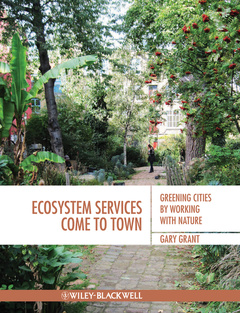Ecosystem Services Come To Town Greening Cities by Working with Nature
Auteur : Grant Gary

Ecosystem Services come to Town: greening cities by working with nature demonstrates how to make urban environments greener. It starts by explaining how, by mimicking nature and deliberately creating habitats to provide ecosystem services, cities can become more efficient and more pleasant to live in. The history of cities and city planning is covered with the impacts of industrial urban development described, as well as the contemporary concerns of biodiversity loss, peak oil and climate change.
The later sections offer solutions to the challenges of sustainable urban development by describing and explaining a whole range of approaches and interventions, beginning at the regional scale with strategic green infrastructure, looking at districts and precincts, with trees, parks and rain gardens and ending with single buildings, including with green roofs and living walls.
Technical enough to be valuable to practitioners but still readable and inspirational, this guide demonstrates to town planners, urban designers, architects, engineers, landscape architects how to make cities more liveable.
About the Author xi
Acknowledgement xiii
1. Introduction 1
Modern Cities and the Disconnected 1
Population Spike 2
Limits to Growth 3
Global Threats 3
Ecosystem Services and Stewardship 4
Greening Cities is Necessary 5
Hope 5
2. Origins of Cities7
Why Look Back? 7
Emergence of the Human Species 7
Great Leap Forward 8
Agriculture and Permanent Settlements 8
Agriculture Around the World 10
Agriculture Intensifies 11
Empires Rise and Fall in Mesopotamia 12
Nile Valley 12
Indus Valley 13
Ancient China 13
Ancient Greece 14
On the Ganges 15
Rome 16
The Moche 16
Mesoamerica 17
Fortified Centres of Administration 17
European Renaissance 18
Early Modern 19
Squalor 21
3. Modern Cities 23
Origins of the Modern City 23
Industrial Revolution 23
Railways 24
Rapid Growth 25
Ill Health 26
Distinctive New Districts Emerge 27
Paris Re-born 28
Railways and Suburbs 29
Planning and Zoning 29
Garden Cities 29
Motor Vehicles Herald in the Oil Age 31
A Humane Outlook 32
Going Up 33
Continued Rise of the Motor Vehicle 33
Decline of the Inner City 34
New Towns 35
City Plans 36
An Unfinished Task 37
4. Issues Facing Contemporary Cities 39
Impacts of Cities and City Living 39
Habitat Loss 40
Habitat Fragmentation 41
Impacts on Soil 41
The Water Cycle 42
Water-borne Pollution 44
Urban Heat Islands 44
Air Pollution 45
Noise 46
Light Pollution 47
Agricultural Land Take 47
Concrete 48
Steel 48
Glass 49
Timber 49
Waste 49
Drivers of Population Growth 50
Peak Oil 52
Peak Phosphorus 52
Post Oil 53
5. Working with Nature 55
Ecology and Ecosystems 55
Born Free 56
Saving the Great Lakes 56
Earth Summit, Ecosystem Assessment and Ecosystem Services 58
Cities as Part of the Biosphere 59
Ecological Restoration 59
Urban Wildlife 60
Green Infrastructure 60
Sustainable Sites Initiative 61
Advice from Professional Bodies and Others 61
Mimic Nature 62
Working with Nature Works 63
6. Urban Nature 65
Open Space Preservation 65
The Naturalists 66
Nature Leaves the City? 66
Urban Nature Returns 68
Wildlife Gardens 69
Encapsulated Countryside 70
Bukit Timah 71
The Urban Forest 72
Urban Wastelands 73
Canvey Wick 74
Emscher Park 75
Urban Farming 76
Biodiversity Action Plans 77
River Corridors 78
London’s South Bank 79
Minneapolis Riverfront 79
7. Water and Cities 81
Fresh Clean Water – Essential and Increasingly Scarce 81
Civilisation has Modified the Water Cycle 82
Water Consumption 82
Embodied Carbon 82
Virtual Water 83
Catchment Management 84
Rainwater Harvesting 84
Grey Water 85
Sustainable Urban Drainage 85
Water Sensitive Urban Design 86
Rain Gardens 86
The Streets are Changing 86
Ponds 88
Potsdamer Platz 89
River Restoration 89
The Cheonggyecheon River 90
Singapore 91
Water and Urban Heat Islands 93
Towards the Water Sensitive City 93
8. City-wide Greening 95
Bioregions 95
Catchment Management for Clean Water 96
Catchment Management for Ecosystem Services 97
Regional Green Infrastructure Plans 99
Biomass and the Bioregion 99
Regional Ecological Networks 100
Community Forests 101
Green Belts 101
Green Grids 103
Transport 103
Urban Heat Islands 105
Blue Networks 105
Masterplanning 107
Regional Plans, Local Implementation 107
9. Greening Neighbourhoods and Buildings 111
Sense of Neighbourhood 111
Living Streets 112
Standardising the Neighbourhood 113
Design Your Own Park 113
A Phoenix Rises 114
Growing Their Own 115
Learning from Squatter Settlements 116
Rain Gardens 117
They Paved Paradise 118
Clapton Park Estate 118
People of the Trees 119
Tree Pits 120
Tree Trenches 121
No Space? 122
Energy Efficient Buildings 123
Water Efficiency 123
Autonomy 123
Building-integrated Vegetation 124
A Coat for Buildings 124
Value of Shade 125
Living Walls 126
Cooling Effect of Green Roofs 128
Green Roofs, Rainwater Attenuation and Cooling 129
Green Roofs Need the Right Substrate 130
Green Roofs for Biodiversity 130
London’s Black Redstart Roofs 131
Biodiverse Green Roofs in North America 132
Roof Gardens for People 133
Worldwide Applications 133
Wildlife and Buildings 134
Rooftop Harvests 136
10. Conclusion 137
Interesting Times 137
The Positives 138
Cities and Citizens Take the Initiative 138
Greening Requires Greenery 140
Appendices
I: award winning projects from IHDC website 141
II: useful resources 177
Notes and References 197
Index 209
Date de parution : 09-2012
Ouvrage de 238 p.
19.1x24.6 cm
Thème d’Ecosystem Services Come To Town :
Mots-clés :
development; cities; increasingly; approaches; urgent; age; new; continuing; demographic; fossil; ecosystem; biodiversity; built; sustainable; essential; environment; environments; nature demonstrates; urban; greener; starts



